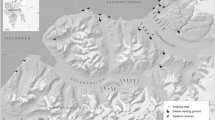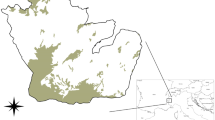Summary
Actual predation is rarely observed in the field, and therefore the role of predators is often severely underestimated. Species are limited in their distribution, which is caused not only by predation but also by the anti-predator behaviour that prey-species have developed under the continuous selection pressure of predators. How finely tuned this behaviour can be, is illustrated in this paper by the way in which Dark-bellied Brent Geese play one predator against another. Snowy Owls keep Arctic Foxes at bay, and so in years when lemmings are abundant Brent Geese can safely nest in association with nesting Snowy Owls. However, this is dangerous in years when lemmings are scarce and Snowy Owls revert to a predatory species that can even take adult Brent Geese on the nest. Another, more common, nesting strategy of Brent Geese is to nest inside Herring Gull colonies on small islands. Herring gulls are not a threat to adult geese, but they can take goose eggs as well as taking a particularly high toll by preying on newly hatched goslings. On the other hand, Herring Gulls are probably useful to Brent Geese as indicators of places which will become fox-free islands after the ice break-up. Moreover the gulls provide additional protection against Snowy Owls as well as against other gulls. Furthermore, through fertilisation by their droppings, the gulls provide the nesting geese with high quality grass during the incubation period. Predator activity and abundance in the arctic is largely a factor of lemming abundance. This paper highlights the ideas we have developed about the impact of predators by comparing data on the breeding success of Brent Geese nesting in the same study area during two complete lemming cycles between 1990 and 1995.
Zusammenfassung
Prädation ist nur selten direkt beobachtbar und so schwer zu quantifizieren. Die Verteilung von Arten ist nicht nur durch Prädation bestimmt, vielmehr kann auch die Räubervermeidung eine Rolle spielen. Wie eng verzahnt dies sein kann, zeigt diese sechsjährige (1990–1995) Studie an Ringelgänsen auf der Taimyr-Halbinsel. In Jahren mit vielen Lemmingen brüten Ringelgänse gemeinsam mit Schneeeulen, die die Polarfüchse vom Brutplatz fern halten. In Jahren mit wenigen Lemmingen dagegen jagen die Schneeeulen Ringelgänse; sie werden vom „Beschützer” zum Räuber. Eine andere Strategie der Ringelgänse ist, auf kleinen Inseln innerhalb von Silbermöwenkolonien zu brüten. Silbermöwen können zwar erhebliche Prädation auf Eier und vor allem frisch geschlüpfte Ringelgänse ausüben. Der Vorteil für die Ringelgänse scheint aber darin zu liegen, dass die Silbermöwen zum einen anzeigen, dass die Inseln frei von Füchsen sind, und zum anderen schützen Silbermöwen vor Schneeeulen. Zudem profitieren die Ringelgänse von der Düngewirkung des Silbermöwenkotes auf die Vegetation. Innerhalb von Silbermöwenkolonien ist die Vegetation reicher als außerhalb. Um Prädation zu vermeiden, begrenzen die Ringelgänse also aktiv ihren Lebensraum. Der wirklich von Ringelgänsen benutzbare Teil der Arktis ist durch Prädatoren und Prädation vermeidendes Verhalten der Gänse eingeschränkt, wodurch die Populationsgröße limitiert ist.
Similar content being viewed by others
References
Ebbinge, B. S. (1989): A multifactorial explanation for variation in breeding performance of Brent Geese. Ibis 131: 196–204.
Ebbinge, B. S. & Spaans, B. (1995): The importance of body reserves accumulated in spring staging areas in the temperate zone for breeding in Darkbellied Brent GeeseBranta b. bernicla in the high Arctic. Journal of Avian Biology 26: 105–113.
Ebbinge, B. S., Berrevoets, C., Clausen, P, Ganter, B., Günther, K., Koffijberg, K., Mahéo, R., Rowcliffe, M., StJoseph, A. K. M., Südbeck, P. & Syroechkovskiy, E. E. (1999): Dark-bellied Brent GooseBranta bernicla bernicla. In : Madsen, J., Cracknell, G. & Fox, A. D. (Eds.): Goose populations of the Western Palearctic. A review of status and distribution. Wetlands International Publ. 48: 284–297.
Greenwood, J.J.D. (1987): Three-year cycles of lemmings and Arctic geese explained. Nature 328:577.
Krebs, C. J. (1993): Are lemmings largeMicrotus or small reindeer? A review of lemming cycles after 25 years and recommendations for future work. In: Stenseth, N. C. & Ims, R. A. (Eds.): The Biology of Lemmings: 247–260. London.
Roselaar, C. S. (1979): Fluctuaties in aantallen KrombekstrandlopersCalidris ferruginea. Watervogels 4: 202–210.
Rykhlikova, M. E. & I. Yu., Popov (2000): Population dynamics and habitat selection of lemmings in arctic tundra of north-western Taimyr. In: Ebbinge, B. S., Mazourov, Y. L. & Tomkovich, P. S. (Eds.): Heritage of the Russian Arctic: Research, Conservation, and International Co-operation. Proceedings of the Willem Barents Memorial Arctic Conservation Symposium held in Moscow, Russia 10–14 March 1998: 544–553. Moscow.
Spaans, B., Blijleven, J., Popov, I., Rykhlikova, M. E. & Ebbinge, B. S. (1998): Dark-bellied Brent GeeseBranta bernicla bernicla forgo breeding when Arctic FoxesAlopex lagopus are present during nest initiation. Ardea 86: 11–20
Spaans, B., Stock, M., St. Joseph, A. K. M., Bergmann, H.-H. & Ebbinge, B. S. (1993): Breeding Biology of Dark-Bellied Brent GeeseBranta bernicla bernicla in Taimyr in 1990 in the Absence of Arctic Foxes and Under Favorable Weather Conditions. Polar Research 12: 117–130.
Summers, R. W. (1986): Breeding production of Dark-bellied Brent Geese Branta bernicla in relation to lemming cycles. Bird Study 33: 105–108.
Summers, R. W. & Underhill, L. G. (1987): Factors related to breeding production of Brent GeeseBranta b. bernicla and waders (Charadrii) on the Taimyr Peninsula. Bird Study 34: 161–171.
Summers, R. W., Underhill, L. G., Syroechkovski Jr., E. E., Lappo, H. G., Prys-Jones, R. P. & Karpov, V. (1994): The breeding biology of Dark-bellied Brent GeeseBranta b.bemicla and King EidersSomateria spectabilis on the northeastern Taimyr Peninsula, especially in relation to Snowy OwlNyctea scandiaca nests. Wildfowl 45: 110–118.
Underhill, L. G., Prys-Jones, R. P., Syroechkovski Jr., E. E., Groen, N. M., Karpov, V., Lappo, H. G., van Roomen, M. W. J., Rybkin, A., Schekkerman, H. & Summers, R. W. (1993): Breeding of waders (Charadrii) and Brent GeeseBranta bernicla bernicla at Pronchischeva Lake, northeastern Taimyr, Russia, in a peak and a decreasing lemming year. Ibis 135: 277–292.
Author information
Authors and Affiliations
Rights and permissions
About this article
Cite this article
Ebbinge, B.S., Spaans, B. How do Brent Geese (Branta b. bernicla) cope with evil? Complex relationships between predators and prey. J Ornithol 143, 33–42 (2002). https://doi.org/10.1007/BF02465456
Accepted:
Published:
Issue Date:
DOI: https://doi.org/10.1007/BF02465456




